Antarctic glacier melting quicker than previously thought
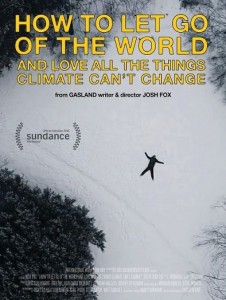 At the Sixth Annual Fort Myers Film Festival this past April, Eric Raddatz, Melissa DeHaven and Executive Producer Toni Gonzales screened a documentary filmed by Josh Fox titled How to Let Go of the World and Love All Things Climate Can’t Change. In the film, Fox highlights the impact of global warming and CO2 emissions on the Arctic ice cap, glaciers and the ice sheets in Antarctica. We now learn that the ice hanging off Antarctica’s western edge is melting at a faster clip than previously documented.
At the Sixth Annual Fort Myers Film Festival this past April, Eric Raddatz, Melissa DeHaven and Executive Producer Toni Gonzales screened a documentary filmed by Josh Fox titled How to Let Go of the World and Love All Things Climate Can’t Change. In the film, Fox highlights the impact of global warming and CO2 emissions on the Arctic ice cap, glaciers and the ice sheets in Antarctica. We now learn that the ice hanging off Antarctica’s western edge is melting at a faster clip than previously documented.
Antarctica is bigger than the United States and Mexico combined, and it is covered in ice more than a mile deep in some places. Most of the ice 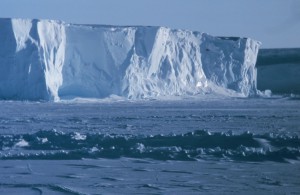 sits on bedrock, but it slowly flows off the continent’s edges. Along the western edge, giant glaciers creep down toward the sea and form ice shelves where they meet the ocean. One of these glaciers is the Smith Glacier, and researchers now estimate that between 2002 and 2009 it lost between 980 and 1,600 feet of ice thanks to
sits on bedrock, but it slowly flows off the continent’s edges. Along the western edge, giant glaciers creep down toward the sea and form ice shelves where they meet the ocean. One of these glaciers is the Smith Glacier, and researchers now estimate that between 2002 and 2009 it lost between 980 and 1,600 feet of ice thanks to 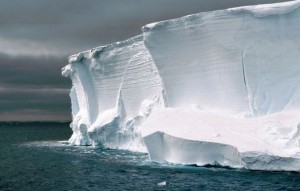 increased melting at the junction where the ice goes from being on land to floating on water (which is technically called a “grounding zone”).
increased melting at the junction where the ice goes from being on land to floating on water (which is technically called a “grounding zone”).
While other regions in Antarctica gained ice and two other western Antarctic glaciers (Pope and Kohler) melted at a slower pace between 2009 and 2014, Smith continued to retreat during this five-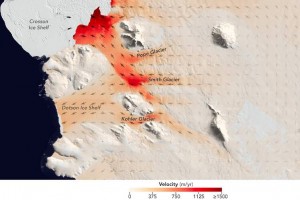 year period. But the relative gains and losses aside, the significance of the new research is what it adds to our understanding of the mechanism by which ice melt in Antarctica adds to sea level rise. Here’s how it works: Warm water attributable to climate change causes glaciers like Smith to melt from the underside or underbelly of the ice shelf. Under
year period. But the relative gains and losses aside, the significance of the new research is what it adds to our understanding of the mechanism by which ice melt in Antarctica adds to sea level rise. Here’s how it works: Warm water attributable to climate change causes glaciers like Smith to melt from the underside or underbelly of the ice shelf. Under 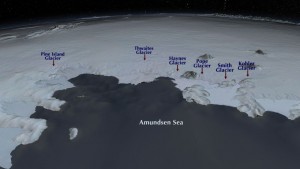 normal circumstances, the melting ice is offset by the rate of gain on the continent. But that balance seems to be off says Dr. Ala Khazendar, a geophysicist and polar expert at NASA’s Jet Propulsion Laboratory in Pasadena, California in a study published in Nature Communications.
normal circumstances, the melting ice is offset by the rate of gain on the continent. But that balance seems to be off says Dr. Ala Khazendar, a geophysicist and polar expert at NASA’s Jet Propulsion Laboratory in Pasadena, California in a study published in Nature Communications.
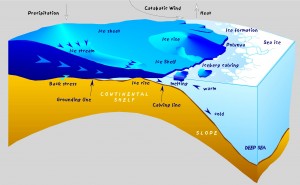 “To study ice shelves, scientists measured ice thickness using radar and laser sensors during flyovers across Antarctica,” writes Daniela Hernandez in todays’ The Wall Street Journal. “Their radar penetrates the ice and allows scientists to ‘see’ the bottom. The laser tells them where the top is. With these data, they can calculate thickness.”
“To study ice shelves, scientists measured ice thickness using radar and laser sensors during flyovers across Antarctica,” writes Daniela Hernandez in todays’ The Wall Street Journal. “Their radar penetrates the ice and allows scientists to ‘see’ the bottom. The laser tells them where the top is. With these data, they can calculate thickness.”
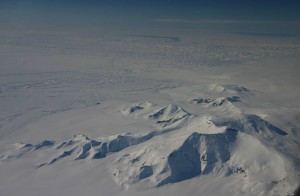 The more the bottom of the Antarctic shelves melt, the more ice is exposed to warm water. “It becomes a runaway process,” explains Dr. Khazendar, “which makes it unstable.” And also irreversible. Khazendar and other polar scientists fear that at some point, the shelves will collapse and Antarctica’s glaciers will flow into the sea. But
The more the bottom of the Antarctic shelves melt, the more ice is exposed to warm water. “It becomes a runaway process,” explains Dr. Khazendar, “which makes it unstable.” And also irreversible. Khazendar and other polar scientists fear that at some point, the shelves will collapse and Antarctica’s glaciers will flow into the sea. But 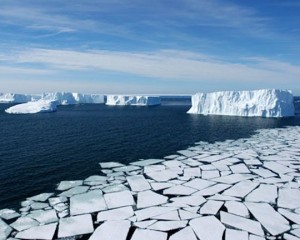 if and when that will happen remains an open question. “And that’s the scary part,” Khazendar says.
if and when that will happen remains an open question. “And that’s the scary part,” Khazendar says.
None of these findings is good news for places like Miami, Louisiana’s Isle de Jean Charles and Barrow, Alaska, which are already under threat from the effects of sea level rise. Since the Fort Myers Film Festival’s closing on April 10, the world has been witnessing the inexorable loss of 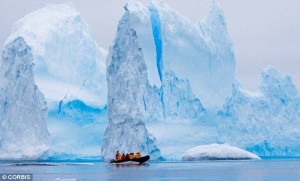 land and habitat to sea level rise, just as Fox predicted in the documentary. In late April, the world learned that five tiny islands in the Soloman Archipelago have disappeared amid rising seas and erosion. In June, UNESCO warned that projected sea level rise threatens more than a dozen World Heritage sites including Venice, Italy, the
land and habitat to sea level rise, just as Fox predicted in the documentary. In late April, the world learned that five tiny islands in the Soloman Archipelago have disappeared amid rising seas and erosion. In June, UNESCO warned that projected sea level rise threatens more than a dozen World Heritage sites including Venice, Italy, the 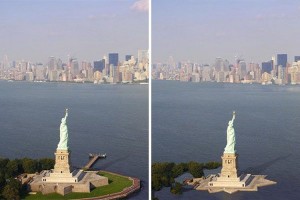 Sydney Opera House, the Galapagos Islands, Stonehenge, Easter Island and the Statue of Liberty. And in August, real estate data firm Zillow warned that the United States alone could lose more than 1.9 million homes if sea levels rise by the six feet projected by climatologists if carbon dioxide emissions continue unabated.
Sydney Opera House, the Galapagos Islands, Stonehenge, Easter Island and the Statue of Liberty. And in August, real estate data firm Zillow warned that the United States alone could lose more than 1.9 million homes if sea levels rise by the six feet projected by climatologists if carbon dioxide emissions continue unabated.
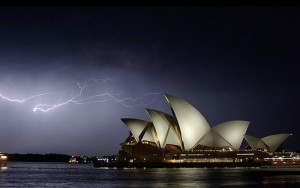 The Paris Accord could result in a reduction of greenhouse gases. And sea walls, barriers and other flood-prevention efforts could help minimize the risk of sea level rise in some areas. But notwithstanding these initiatives, sea levels are going to rise. Insurance companies are anticipating it. Many cities are planning for it.
The Paris Accord could result in a reduction of greenhouse gases. And sea walls, barriers and other flood-prevention efforts could help minimize the risk of sea level rise in some areas. But notwithstanding these initiatives, sea levels are going to rise. Insurance companies are anticipating it. Many cities are planning for it.
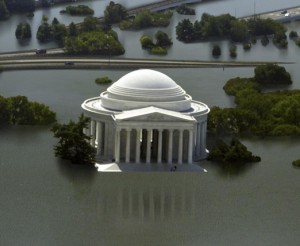 If sea level rise projections are accurate, the state most at risk is Florida, which would account for 934,411 of the 1.9 million homes that could be lost to sea level rise. Miami could lose nearly a third of its housing, though Miami Beach already is spending hundreds of millions of dollars to install pumps and raise sea walls and roads in a bid to stave off encroaching water. The situation is equally dire in Jacksonville, Tampa and Fort
If sea level rise projections are accurate, the state most at risk is Florida, which would account for 934,411 of the 1.9 million homes that could be lost to sea level rise. Miami could lose nearly a third of its housing, though Miami Beach already is spending hundreds of millions of dollars to install pumps and raise sea walls and roads in a bid to stave off encroaching water. The situation is equally dire in Jacksonville, Tampa and Fort 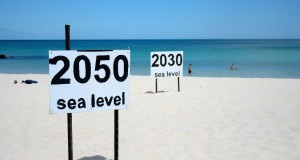 Myers. (Other states at high risk include New Jersey (with 190,429 homes), South Carolina (with 83,833 homes) and Louisiana (with 80,080 homes). Cities in danger include Boston (where one in five homes could be inundated), Honolulu (one in four homes), Virginia Beach, San Diego, Long
Myers. (Other states at high risk include New Jersey (with 190,429 homes), South Carolina (with 83,833 homes) and Louisiana (with 80,080 homes). Cities in danger include Boston (where one in five homes could be inundated), Honolulu (one in four homes), Virginia Beach, San Diego, Long 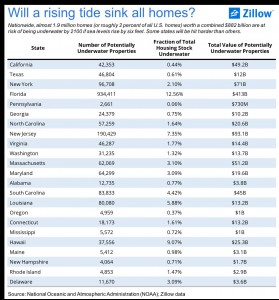 Beach, Seattle and New York.
Beach, Seattle and New York.
Of course, these estimates are based on current home ownership levels. Few communities have imposed a ban on new seaside development. So “given the enduring popularity of living near the sea despite its many dangers and drawbacks, it may be that even more homes will be located closer to the water in a century’s time, and these estimates could turn out to be very conservative,” cautions Zillow. “Either way, left unchecked, it is clear the threats posed by climate change and rising sea levels have the potential to destroy housing values on an enormous scale.”
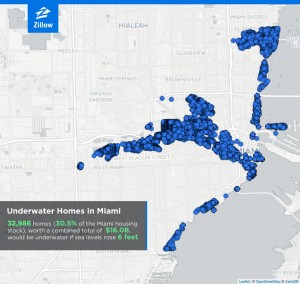 Meanwhile the United States and the world at large await the result of the current presidential contest. Republican candidate Donald Trump vowed again in his Gettysburg speech that, if elected, he will repudiate the Paris Accord, cancel billions of dollars in promised payments to U.N. climate change programs, and lift restrictions on the production of oil, natural gas and coal throughout the country while removing administration roadblocks on energy infrastructure projects including the Keystone XL
Meanwhile the United States and the world at large await the result of the current presidential contest. Republican candidate Donald Trump vowed again in his Gettysburg speech that, if elected, he will repudiate the Paris Accord, cancel billions of dollars in promised payments to U.N. climate change programs, and lift restrictions on the production of oil, natural gas and coal throughout the country while removing administration roadblocks on energy infrastructure projects including the Keystone XL 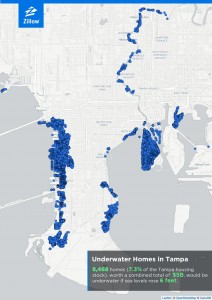 pipeline. In policy terms, Trump’s position can be construed to mean a rolling back of most, if not all, of President Obama’s environmental regulations over the past eight years, from EPA rules on coal ash disposal and natural gas methane emissions to draft regulations on navigable waters. Also up for elimination through a promised Trump executive action would be the entire Clean Power Plan at the heart of Obama’s commitment the Paris climate change agreement.
pipeline. In policy terms, Trump’s position can be construed to mean a rolling back of most, if not all, of President Obama’s environmental regulations over the past eight years, from EPA rules on coal ash disposal and natural gas methane emissions to draft regulations on navigable waters. Also up for elimination through a promised Trump executive action would be the entire Clean Power Plan at the heart of Obama’s commitment the Paris climate change agreement.
Democratic candidate Hillary Clinton states that if elected she will abide by the Paris Accord, oppose drilling in the Arctic and off the coast in the southeastern United States, oppose the Keystone XL pipeline and tighten regulations on fracking. She also says as 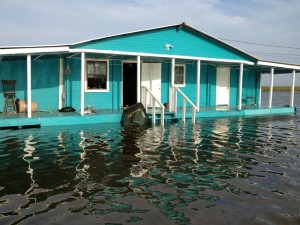 president she would unveil a “Clean Energy Challenge” (CEC), a broad federal program that would partner with states, cities, and rural communities on renewable energy, power grid resilience, and air pollution control. Among other things, the CEC would extend clean energy tax incentives, expand R&D efforts, and increase U.S. hydropower generation. Finally, Clinton claims that as president she would aim to “make the
president she would unveil a “Clean Energy Challenge” (CEC), a broad federal program that would partner with states, cities, and rural communities on renewable energy, power grid resilience, and air pollution control. Among other things, the CEC would extend clean energy tax incentives, expand R&D efforts, and increase U.S. hydropower generation. Finally, Clinton claims that as president she would aim to “make the 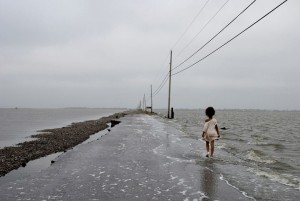 United States the world’s clean energy superpower,” and has announced two proposals to fight climate change: the installation of more than half a billion solar panels by the end of her first term and the generation of enough renewable energy to power every U.S. home within ten years.
United States the world’s clean energy superpower,” and has announced two proposals to fight climate change: the installation of more than half a billion solar panels by the end of her first term and the generation of enough renewable energy to power every U.S. home within ten years.
The fate of towns like Louisiana’s Isle de Jean 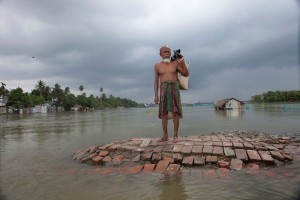 Charles, Barrow, Alaska, Miami and even Fort Myers hangs in the balance.
Charles, Barrow, Alaska, Miami and even Fort Myers hangs in the balance.
Posted October 25, 2016.
Related Articles.
- Skype Q&A with Filmmaker Josh Fox
- Five Pacific islands lost to sea level rise
- United Nations warns that rising sea levels
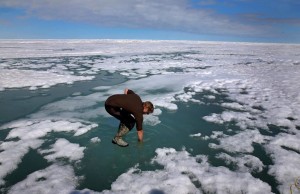 threaten Statue of Liberty
threaten Statue of Liberty - Josh Fox documentary airs on HBO June 27 and all summer long
- Louisiana’s Isle de Jean Charles losing battle to sea level rise
- Residents of Barrow, Alaska on verge of becoming ‘climate refugees’
- Zillow warns that sea level rise could inundate 1.9 million U.S. homes














 Tom Hall is both an amateur artist and aspiring novelist who writes art quest thrillers. He is in the final stages of completing his debut novel titled "Art Detective," a story that fictionalizes the discovery of the fabled billion-dollar Impressionist collection of Parisian art dealer Josse Bernheim-Jeune, thought by many to have perished during World War II when the collection's hiding place, Castle de Rastignac in southern France, was destroyed by the Wehrmacht in reprisal for attacks made by members of the Resistance operating in the area. A former tax attorney, Tom holds a bachelor's degree as well as both a juris doctorate and masters of laws in taxation from the University of Florida. Tom lives in Estero, Florida with his fiancee, Connie, and their four cats.
Tom Hall is both an amateur artist and aspiring novelist who writes art quest thrillers. He is in the final stages of completing his debut novel titled "Art Detective," a story that fictionalizes the discovery of the fabled billion-dollar Impressionist collection of Parisian art dealer Josse Bernheim-Jeune, thought by many to have perished during World War II when the collection's hiding place, Castle de Rastignac in southern France, was destroyed by the Wehrmacht in reprisal for attacks made by members of the Resistance operating in the area. A former tax attorney, Tom holds a bachelor's degree as well as both a juris doctorate and masters of laws in taxation from the University of Florida. Tom lives in Estero, Florida with his fiancee, Connie, and their four cats.